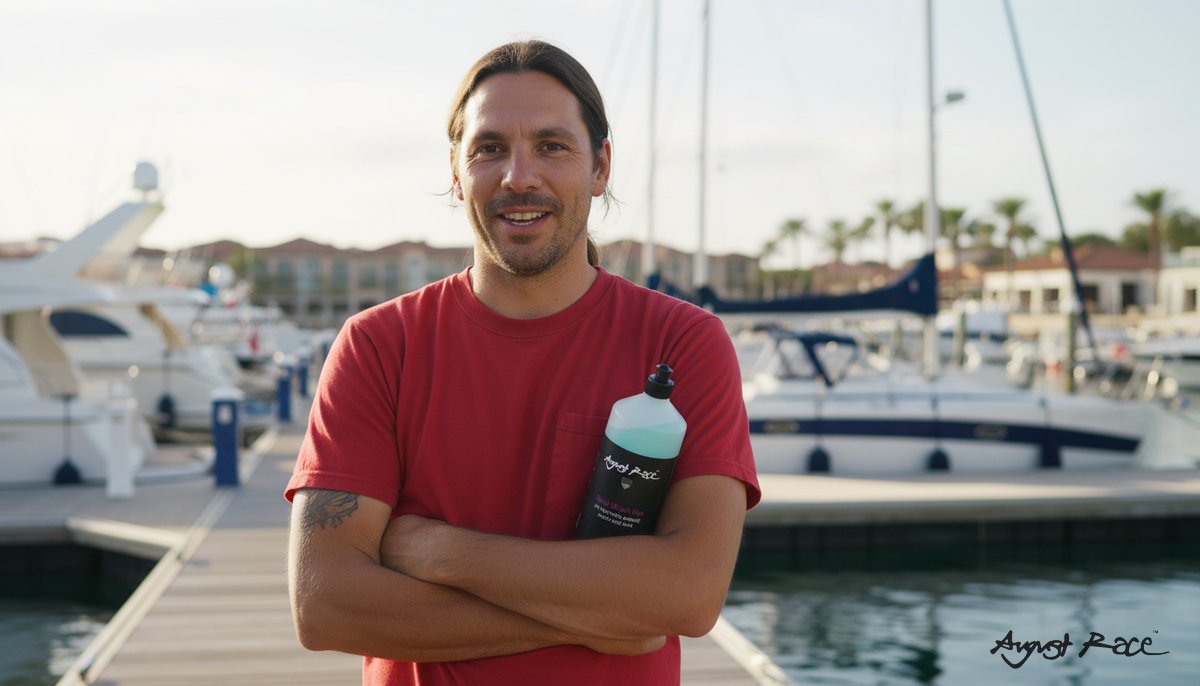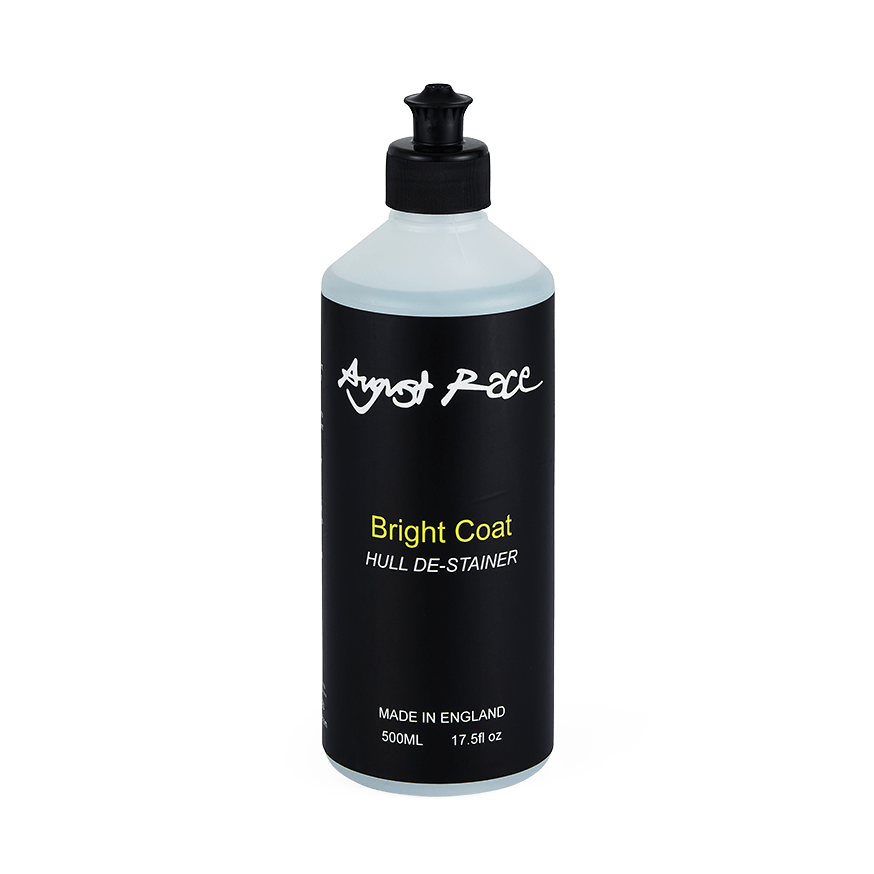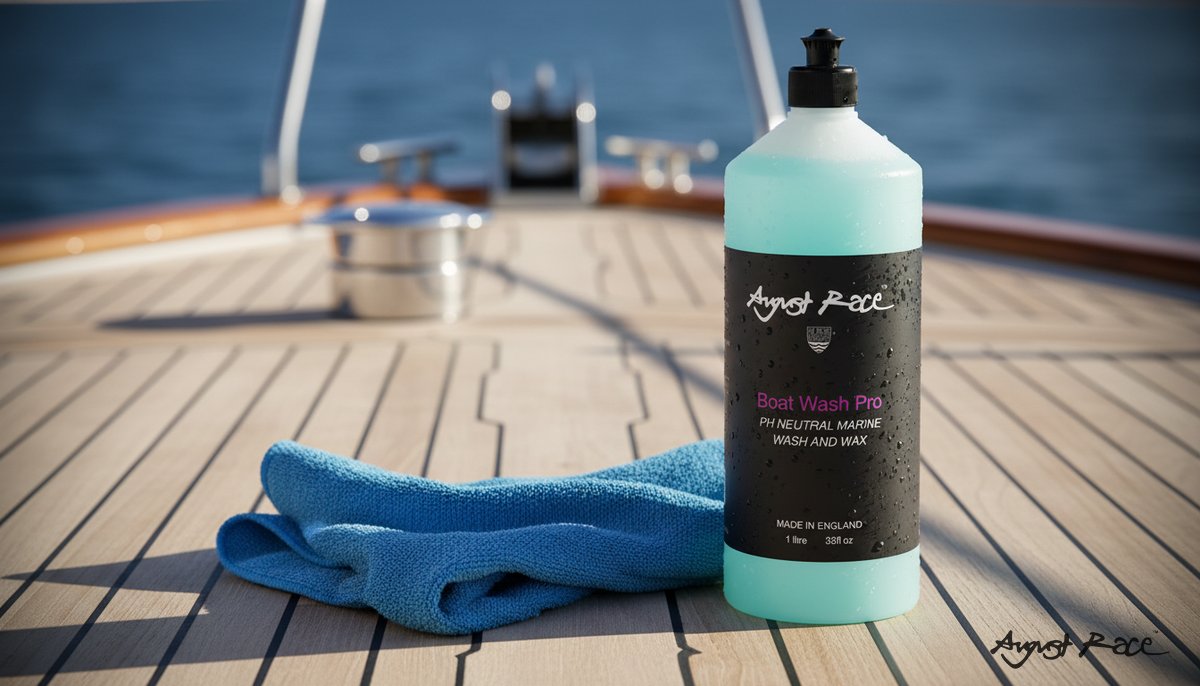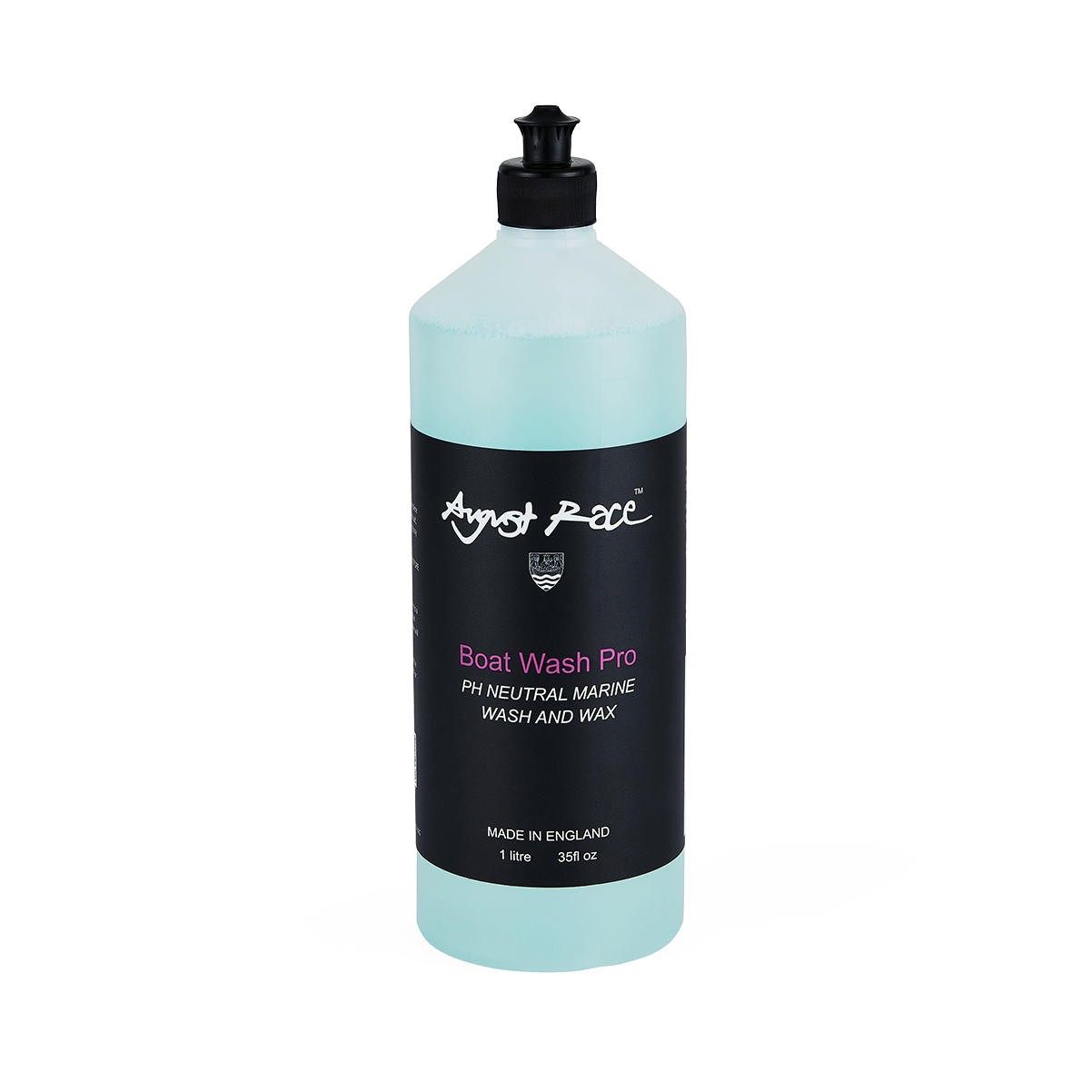Why Pros Choose August Race Boat Wash Pro -- boat cleaning products for streak-free finishes
It’s first light on the marina. The water is flat, gulls are already scouting breakfast, and the hull in front of you wears a week’s worth of salt haze and bird fallout. As a detailing pro, you know the clock and the client will both judge the finish. This is where the right boat cleaning products make or break your day -- and your reputation.
Salt, UV haze, and greasy dock dust fight every pass of your mitt. Cheap soaps leave residue that streaks on dark gelcoat and makes polishing unpredictable. That’s why I reach for August Race Boat Wash Pro when the client expects a show-ready, streak-free finish. It’s become my baseline in marine wash solutions because it lifts grime fast, sheets cleanly, and sets the surface up for efficient compounding and polishing. For pros who insist on eco-friendly boat cleaning products and true streak-free boat wash solutions, it hits the brief without compromising performance.
Below is the exact, repeatable process I use for streak-free finishes with eco-aware chemistry. You’ll get pro-level steps, mixing guidance, and marine surface cleaning tips you can put to work on your next job.
A morning on the dock: why the right boat cleaning products matter
Walk the boat first. Feel the surface with a gloved hand for salt crystals. Note water spots on brightwork and rubber marks along the fenders. Every decision -- from pre-rinse to drying towels -- touches the finish.
The stakes are real:
- Salt crust and mineral spots that etch if you scrub them dry
- Bird fallout that smears when cheap soaps wet it
- UV haze that hides swirls until the boat hits sunlight
With the wrong chemistry, you chase streaks all morning. With the right marine wash solutions, the wash sheets off, you dry once, and your pads stay cleaner during buffing. August Race Boat Wash Pro is the bottle I set on the dock when streak-free results are non-negotiable.
First, here’s what a pro-grade wash has to deliver.
What detailing pros demand from marine wash solutions
Functional requirements:
- Rapid grime lift with minimal dwell time so salt and road film release without aggressive scrubbing
- Safe on gelcoat, painted topsides, vinyl, rubber, and anodized aluminum when used as directed
- Flexible dilution for buckets or foamers; works with soft or hard water
- Rinses clean without leaving a slick film
Finish-focused needs:
- No residue that interferes with cutting compounds or glaze
- No etching or dulling of wax, sealant, or ceramic layers
- Predictable sheeting to minimize water spotting and support streak-free finishes
- Compatible with orbital polishers -- keeps pads from loading with soap residue
Operational realities:
- Low, clean scent that’s pleasant in confined cabins
- Slip-aware on deck; rinses away to reduce hazards
- Biodegradability and eco-aware formulas that play nicely with marina rules and client expectations
Now, let’s connect those demands to how August Race Boat Wash Pro performs on the dock.
How August Race Boat Wash Pro works: formulation and benefits for pros
August Race Boat Wash Pro is built like a pro tool. Its surfactant blend targets salt, light oils, and general dock grime, then releases cleanly on rinse. The pH-balanced formula is designed to be tough on contamination but gentle on gelcoat, paint, and existing wax or sealant layers. Low-foaming characteristics help you see your work on verticals and reduce rinse time.
Why that matters for streak-free finishes:
- Fast sheeting and low residue mean fewer spots as water leaves the surface, especially on dark gelcoat
- A clean, neutral surface makes your polishing stages predictable -- no hidden film that gums pads or fights your cutting cycle
- Reduced rewash risk after compounding; you’re not scrubbing dried soap out of non-skid or rub rails
Workflow compatibility:
- Bucket wash or foam cannon friendly; mix to soil load and local water hardness
- Plays well with cutting compounds and finishing polishes -- rinse leaves a neutral surface for buffing
- Useful as a maintenance wash between details; gentle enough for coated or freshly sealed finishes when diluted properly
Eco-friendly attributes:
- Pros increasingly choose eco-friendly cleaners to align with marina guidelines and client values
- Biodegradable formulas help you clean responsibly without sacrificing results
In short: the chemistry supports speed and quality. Here’s the step-by-step protocol I use to lock in streak-free outcomes.
Pro step-by-step: achieving streak-free boat surfaces with August Race
1) Inspect and plan
- Walk clockwise at gunwale height, then repeat at waterline
- Note oxidation, tannin lines, tar, and rubber scuffs; mark delicate trim and vinyl graphics
- Decide if you need a pre-rinse, a citrus spot cleaner, or a gentle decontamination step later
Pro tip: If the boat is hot from sun, cool panels with a gentle rinse before applying any soap. Hot panels flash-dry and cause streaks.
2) Mix for conditions
- Bucket wash: Start around 1:200 (about 50 mL per 10 L) for routine jobs; bump richer for heavy salt. Always follow the label on your bottle and adjust to soil load and water hardness
- Foam cannon: Fill the cannon bottle at roughly 1:10 with concentrate; your lance will further dilute on the fly. Aim for a wet, clinging foam rather than shaving cream
- Water temperature: Cool to lukewarm is ideal -- warmer water improves cleaning but avoid hot water that can flash-dry on dark topsides
Two-bucket method vs foam cannon:
- Two-bucket with grit guards for close-contact areas (topsides, transom)
- Foam cannon for large surfaces and pre-lube -- follow with a mitt to agitate in straight lines
3) Contact wash technique for streak-free results
- Work top to bottom. Roof and hardtop first, then cabin sides, then topsides, finishing at the boot stripe
- Use linear passes along the length of the hull; avoid circular scrubs that can imprint micro-marring into soft gelcoat
- Pressure: Let the mitt glide. If you need pressure, refoam or enrich the wash mix
- Tools: Use a plush microfiber mitt for topsides and a chenille or noodle mitt for non-skid. Keep a dedicated brush for waterline scum
Pro tip: Refresh your rinse bucket often. Dirty rinse water is a silent streak-maker that re-deposits grime.
4) Rinse and manage water behavior
- Rinse section by section with a free-flowing stream (no spray) to encourage sheeting
- If the water beads too tightly and spots, switch to a gentle spray to knock beads into sheets
- Shadow work: On hot days, chase shade and keep panels wet until you can dry
5) Dry for a spotless, streak-free finish
- Use large, twisted-loop drying towels for flats; pat-dry, don’t drag
- Follow with an air blower for crevices, rails, and around hardware to prevent drips
- Check for recontamination: If your towel shows dirt, rewash that section rather than grinding it in
For show finishes, optionally mist a compatible drying aid on the towel. Keep it light -- August Race’s clean rinse already reduces spotting, and too much product can streak.
6) Prep for polishing and protection
- Tactile test: Back of the hand across the gelcoat. If it feels sandy, consider a clay mitt or fine clay bar with soapy water as lubricant
- Iron fallout: On painted topsides, use a marine-safe iron remover only if you suspect metallic contamination. Always test and rinse thoroughly
- Tape sensitive edges, pick a 2’x2’ test spot, and start with a light cutting compound on a medium foam pad using an orbital polisher. Step up only as needed
This consistent process keeps your finish streak-free and your polishing stages efficient.
Finishing touches: from wash to buff for a professional-grade gloss
A proper wash is the foundation of fast, clean correction. When the surface is residue-free, cutting compounds bite evenly and finish better. Pads run cooler and stay cleaner, and you need fewer passes to clear haze.
Recommended workflow:
- Inspect under good lighting; mark isolated defects
- Light compound where needed with a DA/orbital and a controlled arm speed
- Step down to a fine polish on a finishing pad to refine
- Seal with your choice of GRP Sealer UV or Smooth Opacity UV wax once the surface is squeaky clean and cool
Maintenance between full details:
- Quick rinses with a light dilution of August Race Boat Wash Pro help preserve a streak-free gloss
- Wipe-down protocol: cool surface, clean towel, linear motions, minimal pressure
- Suggest a schedule to clients based on use: weekly light washes for active boats, monthly decontamination for slower seasons
Real results: before-and-after proof and field notes from pros
On a tea-stained river cruiser, a fast pre-foam and bucket wash with Boat Wash Pro cleared a stubborn tannin line without dulling the adjacent wax. The follow-up polish took a single pass with a medium pad to restore a wet-look gloss. On a black hull sloop, clean sheeting and a careful dry-down kept the topsides free of streaks even under noon sun.
Field notes from busy yards:
- Cleaner rinse leaves fewer patches to rewash before compounding
- Pads load less with soap film, helping cut time on step-one correction
- Dark gelcoat behaves predictably -- less chasing water spots across panels
Worried that eco-friendly cleaners are weak? Pros report the opposite when the formulation is balanced: controlled cleaning, no harsh bite, and a finish that’s easier to perfect. Concerned about streaking on dark colors? The key is sheeting rinse, cool panels, and disciplined drying -- this product supports that workflow.
Picking the right products for your pro kit: stocking tips and pairings
Complementary boat detailing products that pair well with Boat Wash Pro:
- Clay mitt or fine clay bar for seasonal decontamination
- Cutting compounds in at least two strengths and matching foam/microfiber pads
- Finishing polish for final clarity, plus a durable marine sealant or wax
- Quick detail or drying aid that won’t smear -- test for compatibility on a small panel
- For vinyl and upholstery, reach for Vinyl Bright cleaner
- Restore fenders between washes with August Race Fender Clean
- For RIB tubes, use Liquid RIB cleaner and protect with LR Sealer UV
Inventory planning:
- Keep labeled, dilution-ready bottles for “maintenance,” “standard,” and “heavy” mixes
- For busy seasons, stock enough concentrate to cover your average weekly volume; many pros keep several liters on hand to avoid mid-week runs
- Log your actual mix rates per boat size so you can forecast consumption accurately
Client communication and pricing:
- Present eco-friendly boat cleaning products as a premium, responsible service
- Explain how streak-free finishes reduce rework and support longer-lasting protection
- Tie your labor rate to your process: inspection, controlled wash, precise drying, and a smarter correction plan
Try it on your next job: pro offer and getting started
Put August Race Boat Wash Pro into your real workflow. Run it on your next client’s topsides and track the time you spend washing, drying, and prepping for polish. Compare your pads after step one -- cleaner pads usually mean faster correction and better results.
Try this low-risk test:
- Wash and dry one boat with your current soap, then the next with Boat Wash Pro using the protocol above
- Photograph panels in direct sun before and after to verify streak-free finishes and reduced spotting
Ready to stock up? Grab sample sizes or bulk quantities of August Race Boat Wash Pro at the August Race shop, add it to your standard quote package, and let your clients know you’re using eco-friendly cleaners that deliver professional results. Precision and the right chemistry make this work satisfying -- and repeatable.
FAQs for pros: quick answers to common long-tail questions
What dilution ratio should pros use for August Race Boat Wash Pro to achieve streak-free results?
Follow the label on your bottle first, then adjust to soil load and water hardness. As a practical starting point, many pros run around 1:200 in a wash bucket for maintenance washes and enrich slightly for heavy salt; in a foam cannon, mix roughly 1:10 in the reservoir and fine-tune for a wet, clinging film. Always work cool panels and rinse to a sheet to avoid spotting.
Is August Race Boat Wash Pro safe on dark gelcoat and painted surfaces without causing streaks?
It’s designed to be safe on gelcoat and painted finishes when used as directed, and its clean rinse helps reduce streaking on dark colors. Work in the shade, keep panels cool, and use a sheeting rinse followed by controlled drying to lock in a streak-free finish. When in doubt, test a small, inconspicuous area first.
How do eco-friendly boat cleaning products compare in performance to conventional marine wash solutions?
Modern eco-friendly cleaners use balanced surfactant systems that lift salt and light oils effectively without harsh bite. In practice, you get controlled cleaning, a cleaner rinse, and less interference with compounds and sealants. The key is using proper dilution and technique -- eco-aware chemistry plus pro process equals top-tier results.
Can I use August Race Boat Wash Pro through a foam cannon and still get a streak-free finish?
Yes -- Boat Wash Pro works well through a foam cannon as a pre-lube and contact wash aid. Dial your mix so the foam wets and clings rather than creating super-thick suds, then agitate with a mitt and rinse to a sheet. Follow with disciplined drying to leave the surface streak-free and ready for polishing.
About the Author
Sarah Rodriguez
The Detailing Professional
Owner of a high-end marine detailing business catering to luxury yachts and charter fleets. Sarah's reputation and business depend on delivering flawless results efficiently.
Expertise:
Get Expert Tips
Subscribe for marine care insights and product updates from industry professionals.
No spam. Unsubscribe anytime.
You May Also Like

Gelcoat Cleaning: Remove Salt Buildup | Boat Wash Pro
Stop salt haze fast. A yacht owner’s gelcoat cleaning routine using biodegradable Boat Wash Pro -- marine grime removal and streak-free results, marina-safe.

Fast Gelcoat Stain Remover for Marina Ops | Bright Coat
How our marina teams remove rust stains and yellowing fast with a non-abrasive gelcoat treatment -- scalable SOPs, batching tips, and a pilot plan.

Remove Salt Buildup on Gelcoat | Boat Wash Pro Guide
Stop salt haze on gelcoat the smart way. Use August Race Boat Wash Pro for gentle, streak-free, biodegradable cleaning and lasting gloss.
